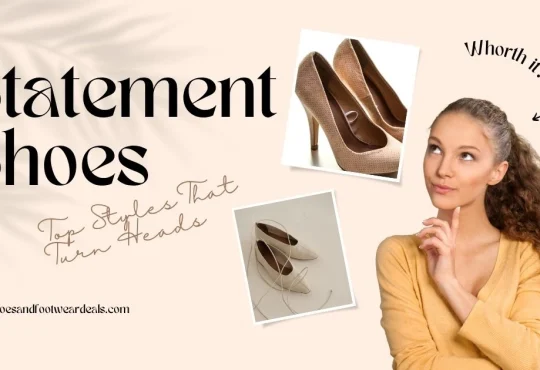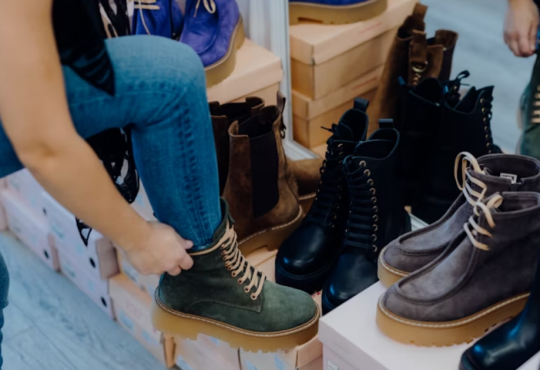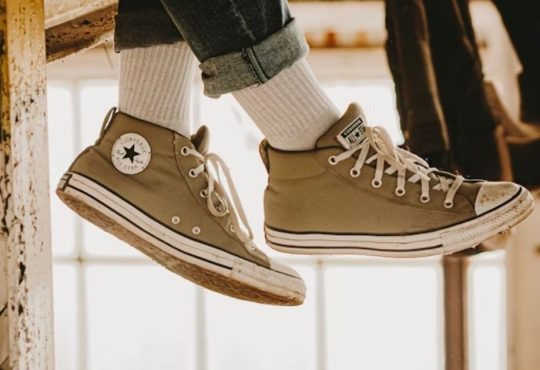Winter footwear should do two things well. It must keep feet warm and dry. It must also provide traction and support on icy or slippery surfaces. The 2025 roundups and lab tests show that the best winter shoes blend insulation, waterproofing, and durable outsoles while remaining comfortable for daily use. This guide to winter shoes for women explains key features, top types, and care tips to stay warm, safe, and comfortable in cold weather.
What Makes A Great Winter Shoe
A reliable winter shoe is more than just a lined boot. The most important features are:
- Insulation. Look for boots rated for appropriate temperature ranges or with high-quality liners such as recycled felt, PrimaLoft, or shearling. Insulation traps heat, keeping toes comfortable on cold days.
- Waterproofing. Sealed seams, waterproof membranes like Gore-Tex, and treated leather prevent meltwater and slush from soaking through to the foot. Waterproofness is essential for long walks, commuting, and snowy chores.
- Traction. Deep lugs, sticky rubber compounds, and specialized treads reduce the risk of slips on ice and packed snow. Some brands also offer optional spikes or built-in studs for extreme conditions.
- Fit and support. A secure heel and supportive midsole maintain balance in slippery conditions. Roomy toe boxes allow for thicker socks without compressing the feet.
- Ease of entry and maintenance. Practical closures, removable liners, and durable materials matter for repeated winter wear and seasonal storage.
When shopping for winter shoes, prioritize the features that match daily needs. A long walk in subzero temperatures calls for a different pair of shoes than a short, slushy commute.
Types Of Winter Shoes for Women And When To Wear Them
1. Snow And Park Boots For Deep Winter
Snow boots are designed for heavy snow, subfreezing temperatures, and long exposure to the elements. They typically have tall shafts, thick insulation, and waterproof outsoles.
Best for: Commuting in heavy snow, shoveling, winter travel, and outdoor chores.
Recommended models and why: Classic workhorse options like the Sorel Joan of Arctic are repeatedly praised for warmth, durability, and waterproof construction. UGG Adirondack-style boots combine a luxurious liner with waterproof leather for cold-weather climates that also value comfort. For budget-friendly and utility-driven options, brands such as Columbia and Baffin offer insulated, waterproof models that testers recommend for value and performance.
2. Insulated Hiking Boots And Trail Shoes
Modern insulated hiking boots deliver warmth plus performance. These shoes combine rugged outsoles, waterproof membranes, and technical insulation for days on icy trails or winter hikes.
Best for: Winter hiking, backcountry approaches, and mixed terrain walks.
Recommended models and why: The Hoka Anacapa Mid GTX and similar models earned top marks in multi-brand tests for comfort, traction, and warmth. Look for boots with Gore-Tex or equivalent membranes and aggressive lug patterns.
3. Waterproof Leather Boots For City Life
Waterproof leather ankle boots and Chelsea boots are practical for urban winter conditions. When treated and lined, these shoes look polished and keep feet warm during commutes and social outings.
Best for: City walking, office commutes, and everyday wear where style matters.
Recommended models and why: Leather boots from tried-and-true brands that feature seam-sealed construction and thin, warm linings perform well. Look for models with rubberized or lug soles and consider options with removable liners for drying and cleaning. Editorial roundups list several mid-height boots and waterproof leather options that balance fashion and function.
4. Insulated Winter Sneakers And Hybrid Trainers
Insulated sneakers and hybrid trainers are lighter alternatives for urban winter life. These shoes offer more agility and can be a comfortable option for mild winter climates.
Best for: Short commutes, slushy sidewalks, and casual errands in milder winter weather.
Recommended models and why: Brands such as The North Face, KEEN, and newer hybrid lines from sneaker brands pair waterproof treatments with insulated linings. The trend toward insulated sneakerinas and retro runners with weatherproof uppers makes this category especially versatile.
5. Rugged Work Boots And Slip-Resistant Shoes
Work boots with insulation, steel or composite toes, and true slip-resistant outsoles are essential for specific job sites, outdoor labor, and long periods on hard, icy surfaces.
Best for: Outdoor workers, first responders, and anyone needing certified slip resistance and toe protection.
Recommended models and why: Muck Boot Company and other industrial boot makers produce highly insulated, rated footwear for heavy-duty winter use. Slip-resistant shoes from brands with a safety focus are also available in women-specific fits.
How To Choose The Right Winter Shoe For Your Climate
- Mild winter, wet conditions. For climates that see rain and occasional light snow, waterproof leather boots or insulated sneakers with good tread are ideal. Focus on waterproofing and breathability.
- Cold winter with heavy snow. Choose tall, highly insulated snow boots with removable liners. Prioritize warmth ratings and deep lugged soles. Sorel and Baffin have established reputations in this category.
- Mountain or trail winter conditions. Select insulated hiking boots with a waterproof membrane and a grippy, stable outsole. Consider compatibility with traction devices if icy trails are common.
Consider how often shoes will be exposed to moisture. Repeated wetting and drying can damage insulation and leather. If the feet will be in slush or water frequently, choose fully waterproof constructions rather than water repellent finishes.

Fit, Socks, And Layering For Maximum Warmth
Sizing for winter footwear differs from that for summer shoes. Allow room for thick wool or thermal socks. However, excessive looseness can create cold spots because warm air will not circulate properly.
- Socks. Use merino wool or blended thermal socks for warmth without bulk. Avoid cotton in winter boots, as it tends to retain moisture.
- Lining and liner removal. Boots with removable liners make drying and storage easier. A good liner also allows adjustments to sock layering for variable conditions.
- Toe room. Leave a thumb’s width of space between the longest toe and the front of the boot when wearing the winter socks. This prevents toes from hitting the front during downhill walks and maintains circulation.
Traction And Anti-Slip Options
Traction is one of the most important safety attributes for winter shoes. Key solutions include:
- Sticky rubber outsoles that remain pliable in cold temperatures.
- Deep, multidirectional lugs that bite into snow and slush.
- Built-in studs or optional microspikes and crampons for ice. Some models accept clip-on traction devices.
For city dwellers, portable slip-on ice cleats are a practical accessory. They roll up small for storage and dramatically reduce the risk of falling on black ice.
Recommended Models Based On Reviews
The following models appeared across multiple 2025 reviews and buyer guides for their combination of warmth, waterproofing, and traction.
- Sorel Joan of Arctic. Longstanding pick for consistent warmth and durability in snowy climates. Testers praise its insulation and repairable liner system.
- UGG Adirondack III. Known for cozy linings and practical waterproof leather, this model is often recommended as an investment winter boot.
- Hoka Anacapa 2 Mid GTX. A top choice for insulated hiking performance with reliable traction and comfort for longer winter walks.
- Columbia Ice Maiden II. Strong budget pick with thermal insulation and a consumer-friendly price point. Good for light snow and cold commutes.
- Muck Arctic Sport II Tall. Industrial strength, designed for winter work and heavy exposure to snow. Excellent insulation and waterproofing.
Local needs and foot shape matter. Trying shoes in store with winter socks, or ordering from retailers with generous return policies, helps ensure the right fit.
Caring For Winter Shoes
Proper care extends the life and performance of winter footwear.
- Drying. Never place wet boots directly on intense heat sources. Instead, dry at room temperature with crumpled newspaper or boot dryers that circulate gentle warm air. Removable liners and insoles speed the process.
- Cleaning. Rinse off salt and slush promptly. Use cleaners appropriate for leather, suede, or synthetic materials. Follow with conditioning or waterproofing treatments recommended by the manufacturer.
- Storage. Store boots in a cool, dry place. Remove liners and let them air out before seasonal storage to prevent mildew. Treat leather annually to maintain water resistance.
Sustainability Considerations
Sustainability matters for many shoppers. Several brands have increased recycled content in insulation and uppers and offer repairable liners or take-back programs. When possible, prioritize models that use recycled insulation, water-based adhesives, and long-lasting outsoles to reduce the environmental impact over the life of the shoe. Retailer and brand sustainability statements help compare materials and manufacturing practices.
Packing And Travel Tips For Cold Destinations
- Pack a versatile mid-height winter boot for warmth and a waterproof leisure shoe for city sights.
- Carry compact traction devices when traveling to icy destinations. They fold down and save space.
- Use boot bags or wraps to protect clothing in luggage. Remove liners and dry before packing if possible.
- Bring a small tube of leather conditioner and a brush for on-the-road touch-ups.
The Essential Wrap Up for Winter Shoe Selection
Choosing winter shoes is a balance between insulation, waterproofing, traction, and fit. The strongest performers combine thoughtful technical features with comfortable, wearable design. Established winter boot models from Sorel and UGG continue to earn high marks in 2025 reviews for cold-weather performance. For active winter users, insulated hiking boots provide the best balance of support and traction. Urban wear benefits from waterproof leather and compact lug soles that keep commuters safe on icy sidewalks. With the right pair and a little maintenance, cold weather becomes much more manageable and safer for everyday life.





